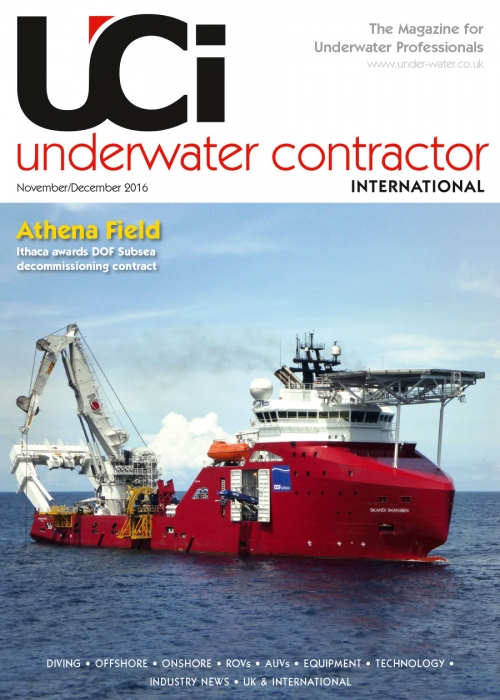
The Magazine for Underwater Professionals
![]() May/Jun 2016
May/Jun 2016
INDUSTRY NEWS - OPERATIONS
Kongsberg makes monster discovery
Time after time the search has been made, and time after time, they’ve all come back empty handed. However, Kongsberg Maritime Ltd, the United Kingdom division of Kongsberg Maritime, Norway, has achieved the unimaginable and uncovered the elusive Nessie. That is, the long lost model of Nessie that was used during filming of The Private Life of Sherlock Holmes, the 1970 movie directed and produced by Billy Wilder.
The discovery was made during a survey of Loch Ness, led by Kongsberg Maritime Ltd and supported by The Loch Ness Project and VisitScotland.
Operation Groundtruth is the first survey of its kind in Scotland making use of Kongsberg Maritime Ltd’s recently launched MUNIN AUV. The autonomous underwater vehicle features advanced sonar and camera equipment, which provide the ability to map vast areas up to a depth of 1500 metres at high resolution, the company said.
As Loch Ness has a reputation of being incredibly difficult to survey, the state-of-the-art MUNIN will undoubtedly reveal brand new information regarding the Loch. Uncovering the 46-year old Nessie model was just the beginning.
Craig Wallace, senior subsea applications engineer at Kongsberg Maritime Ltd, is excited to be back at a favourite location. “Kongsberg Maritime Ltd began surveying Loch Ness with some of the world’s first multibeam sonar back in 1987,” he said. “Over the years, the company has returned many times, bringing the latest technology to uncover the Loch’s mysteries.
“We expect to uncover new information from the Loch during this survey, as MUNIN is the most advanced low logistics AUV on the market and is the first of the next generation AUVs from Kongsberg Maritime. Merging the cutting edge technology from the commercial sector whilst maintaining the robust reliability from the military market, the vehicle is providing insight to the Loch’s depths as never before imagined. Finding Nessie was, of course, an unexpected bonus.”
The MUNIN AUV, which has been added to Kongsberg Maritime Ltd’s Aberdeen-based rental pool, offers significant benefits in terms of low utilisation costs, high reliability, an excellent standard of data quality and easy deployment, according to Wallace.
Oman’s Ministry of Heritage & Culture (MHC) in cooperation with Blue Water Recoveries (BWR) of West Sussex, UK, have announced the discovery and archaeological excavation of a Portuguese East Indiaman that was part of Vasco da Gama’s 1502-1503 Armada to India. The ship, which sank in a storm in May 1503 off the coast of Al Hallaniyah island in Oman’s Dhofar region, is the earliest ship from Europe’s Age of Discovery ever to be found and scientfically investigated by a team of archaeologists and other experts.
Details of the wreck site, published in the International Journal of Nautical Archaeology, reveal that the ship is believed to be the nau Esmeralda commanded by Vicente Sodré, who was the maternal uncle of Vasco da Gama and a descendent of the nobleman Frederick Sudley of Gloucestshire, UK.
The wreck site was initially discovered by a BWR team in 1998, on the 500th anniversary of Vasco da Gama’s epic discovery of the direct sea route to India, but full-scale archaeological survey and excavation by the MHC did not begin until 2013. Since then two more excavations have been conducted in 2014 and 2015, with more than 2800 artefacts being recovered. The project has been jointly managed by the MHC and David Mearns of BWR.
Key individual artefacts that helped in identification of the wreck site as Vicente Sodré’s nau Esmeralda include: an important copper-alloy disc marked with the Portuguese royal coat of arms and an esfera armilar (armillary sphere), which was the personal emblem of King Dom Manuel I; a bronze bell with an inscription that suggests the date of the ship was 1498; gold cruzado coins minted in Lisbon between 1495 and 1501; an extraordinarily rare silver coin, called the Indio, that was commissioned by Dom Manuel in 1499 specifically for trade with India. The extreme rarity of the Indio (there is only one other known example in the world) is such that it has legendary status as the ‘lost’ or ‘ghost’ coin of Dom Manuel.
The bulk of the recovered artefacts were artillery and ordnance from the arsenal on board the ship. These included lead, iron and stone shot of various calibres, a large number of bronze breech chambers and several ancient firearms. Together they provide tangible proof of the military objectives of this fleet as ordered by Dom Manuel and brutally carried out by Vasco da Gama and his two uncles Vicente and Brás Sodré.
The historical and archeological importance of the wreck site, based on future studies of the artefact assemblage, could be enormous. As one of the very early Ships of Discovery that pre-dates the nearest Iberian shipwreck in age by 30 to 50 years, the artefacts are expected to reveal new discoveries about how maritime trade and warfare was conducted in the Indian Ocean at the turn of this vital century.
“This project differs from the majority of maritime archaeology projects in that we set out to specifically find the wreck site of the Sodré ships, using a suvivor’s and other historical accounts, because of their very early age and the potential they held for new discoveries. It is extremely gratifying therefore that this strategy has paid off with such interesting revelations even though we are still at a relatively early stage in the study of the artefact assemblage,” said David Mearns.
For further information, visit www.esmeraldashipwreck.com.


